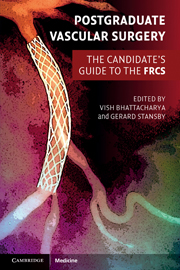Book contents
- Frontmatter
- Contents
- List of contributors
- Preface
- Section 1 Final FRCS vascular clinicals
- Section 2 Final FRCS vascular topics
- 1 Vascular risk factors and their management
- 2 Management of acute limb ischaemia
- 3 Chronic lower limb ischaemia, critical ischaemia and the diabetic foot
- 4 Endovascular and surgical options for peripheral revascularisation
- 5 Abdominal aortic aneurysms
- 6 Thoracic, thoracoabdominal and suprarenal aortic aneurysms
- 7 Aortic dissection
- 8 Popliteal artery aneurysms
- 9 Femoral artery aneurysms
- 10 Carotid, subclavian and vertebral disease
- 11 Diagnosis and management of thoracic outlet syndrome
- 12 Diagnosis and management of hyperhidrosis
- 13 Chronic mesenteric ischaemia
- 14 Acute ischaemic colitis
- 15 Vascular trauma
- 16 Indications and management of lower limb amputation
- 17 Leg swelling and lymphoedema
- 18 Varicose veins and chronic venous insufficiency
- 19 Management of deep vein thrombosis
- 20 Infection in vascular surgery
- 21 Vascular malformations
- 22 Vasospastic disorders and vasculitis
- 23 Critical care considerations and preoperative assessment for general and vascular surgery
- 24 Access surgery
- 25 Basic outline of solid organ transplantation
- Index
- References
11 - Diagnosis and management of thoracic outlet syndrome
- Frontmatter
- Contents
- List of contributors
- Preface
- Section 1 Final FRCS vascular clinicals
- Section 2 Final FRCS vascular topics
- 1 Vascular risk factors and their management
- 2 Management of acute limb ischaemia
- 3 Chronic lower limb ischaemia, critical ischaemia and the diabetic foot
- 4 Endovascular and surgical options for peripheral revascularisation
- 5 Abdominal aortic aneurysms
- 6 Thoracic, thoracoabdominal and suprarenal aortic aneurysms
- 7 Aortic dissection
- 8 Popliteal artery aneurysms
- 9 Femoral artery aneurysms
- 10 Carotid, subclavian and vertebral disease
- 11 Diagnosis and management of thoracic outlet syndrome
- 12 Diagnosis and management of hyperhidrosis
- 13 Chronic mesenteric ischaemia
- 14 Acute ischaemic colitis
- 15 Vascular trauma
- 16 Indications and management of lower limb amputation
- 17 Leg swelling and lymphoedema
- 18 Varicose veins and chronic venous insufficiency
- 19 Management of deep vein thrombosis
- 20 Infection in vascular surgery
- 21 Vascular malformations
- 22 Vasospastic disorders and vasculitis
- 23 Critical care considerations and preoperative assessment for general and vascular surgery
- 24 Access surgery
- 25 Basic outline of solid organ transplantation
- Index
- References
Summary
Key points
Thoracic outlet syndrome (TOS) can be neurogenic, venous or arterial
Neurogenic TOS is the commonest presentation, seen in 90% of cases
Arterial presentation is very rare but may be more dramatic with digital gangrene
TOS is due to extrinsic compression from fibrous bands, cervical rib or first rib
Physical examination may be helpful with the Roos test being positive in the majority
Plain X-rays, Duplex and magnetic resonance angiography (MRA) may be helpful but the diagnosis is mainly clinical
Electrophysiology testing is non-specific although median antebrachial nerve response has recently shown to be useful
Removal of fibrous bands, cervical ribs and the first rib may be needed along with anterior scalenectomy
Arterial reconstruction of the subclavian artery may be required
Introduction
TOS is one of the most controversial clinical entities in medicine. This is partly because there is no definitive diagnostic test and debate continues as to whether the syndrome even really exists in some of its forms! Its incidence has been estimated at 5:100,000 per year in the UK although the true figure is still unknown.
The thoracic outlet is the region at the top of the rib cage between the base of the neck and the axilla through which the brachial plexus and the subclavian vessels travel. The first channel is the interscalene triangle, which is bordered by the scalenus anterior, scalenus medius and the medial border of the first rib (Figure 11.1).
- Type
- Chapter
- Information
- Postgraduate Vascular SurgeryThe Candidate's Guide to the FRCS, pp. 146 - 151Publisher: Cambridge University PressPrint publication year: 2011
References
- 1
- Cited by



